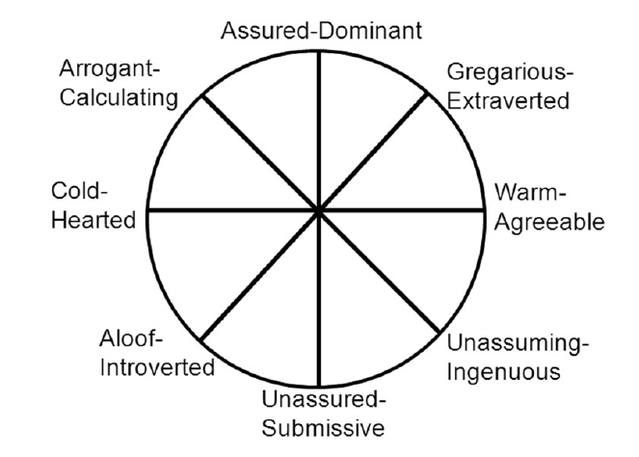Personality
Personality's 'Big One' and the Enigma of Narcissism
Narcissism is a complex mix of adaptive and maladaptive traits
Posted November 29, 2015
Narcissism is a complex and puzzling personality trait. Narcissists can be quite effective in getting what they want from other people due to their charm and self-assurance, yet their selfish, aggressive behavior tends to alienate others. Narcissism can cause frequent interpersonal problems, yet narcissists generally seem to be happy and have high self-esteem. People who study narcissism are interested in how it fits in with wider theories about the structure of personality. Narcissism is included in the ‘dark triad’ of antagonistic personality traits, along with Machiavellianism and psychopathy. More recently, some scholars have argued that narcissism should be separated from the dark personality cluster due to its positive characteristics. This argument is particularly relevant to those who propose that all the positive and adaptive personality traits have a common foundation in a general factor of personality. Dark traits, in this view, should represent the negative pole of a general factor, with the ‘bright’ traits at the positive pole. However, it is unclear how narcissism should fit into such a unitary model, as it combines both dark and bright features. The general factor of personality is said to represent a dimension of social effectiveness. However, narcissism may be an alternative route to social effectiveness, but one that is focused on selfish interests and short-term goals.

The defining feature of narcissism is the desire to maintain a grandiose sense of self. Narcissists think they are very special people indeed and want everyone to know it. Most people want others to like them, but narcissists want others to admire them for their greatness. Many narcissists have good social skills, are self-confident and charming and are very assertive in promoting their own interests. They also tend to be highly competitive, try to derogate those they see as rivals, and respond very aggressively to insults and perceived slights. Although they quickly impress people on first acquaintance, their popularity tends to decline as people get to know them. While others may perceive them as attractive and competent, they are also seen as aggressive and untrustworthy (Back et al., 2013). Although narcissists can generate problems for people who have to deal with them, many narcissists themselves tend to report that they are generally happy with their lives and have high self-esteem (Rose & Campbell, 2004; Sedikides, Rudich, Gregg, Kumashiro, & Rusbult, 2004).[1]
People who study narcissism, have linked it to broader features of personality in a number of ways. For example, narcissism has been examined as part of a group of antisocial personality traits known as the Dark Triad, along with psychopathy (callous disregard for the rights of others) and Machiavellianism (a cynical, manipulative approach to social interaction). Although all three members of this dark triad have their own distinctive features, there is considerable overlap between them and they all share a common core of interpersonal antagonism (Jones & Figueredo, 2013). Although all members of the dark triad are socially aversive, psychopathy is considered the most malevolent and therefore the ‘darkest’ of the triad, followed closely by Machiavellianism. Narcissism is considered the least dark because some its features are more appealing to other people.
A more general personality model that has been applied to the dark triad and narcissism in particular is the interpersonal circumplex. This model focuses on two dimensions of interpersonal behavior known respectively as agency (getting ahead and attaining social status) and communion (getting along with others and maintaining warm relationships). People can display any combination of these two dimensions. People high in dark triad traits, including narcissism tend to be high in agency and low in communion (Furnham, Richards, & Paulhus, 2013), a combination known as ‘arrogant-calculating’.

Another approach to the dark triad has been the application of the well-known Big Five model, consisting of extraversion, agreeableness, conscientiousness, neuroticism, and openness to experience. The arrogant-calculating area of the interpersonal circumplex is particularly associated with low agreeableness, and research using the Big Five has found that the most consistent feature shared by all members of the dark triad is low agreeableness, indicating a common core of selfish disregard for others. Apart from low agreeableness, narcissism seems to be more psychologically adaptive than psychopathy and Machiavellianism, and this may be because they are related to the other Big Five traits in different ways. Specifically, narcissism tends to be associated with very high extraversion, and somewhat high conscientiousness and openness to experience, and with low neuroticism. Psychopathy and Machiavellianism are both associated with low conscientiousness, and tend to be unrelated to the remaining traits with the exception that Machiavellianism tends to be associated with higher neuroticism. A combination of high extraversion and openness to experience is associated with social influence, while low neuroticism is associated with better psychological adjustment. This seems to fit the profile of narcissists as socially poised and self-confident people. Very low conscientiousness on the other hand, tends to be associated with behavior that can get a person into all kinds of trouble, such as drug use and delinquency, and this fits with the perception of psychopathy and Machiavellianism as being particularly dark. Consequently, some people have argued that instead of the dark triad it might be more useful to think of psychopathy and Machiavellianism as forming a ‘dark dyad’ with narcissism as a separate although related concept (Egan, Chan, & Shorter, 2014).
Both the interpersonal circumplex and the Big Five models are based on the premise that there are a number of separate and independent factors that make up someone’s personality. In contrast to these, a more recent theory proposes that all the many different personality traits derive from variations in a single underlying dimension known as the general factor of personality (GFP). As I have discussed in a number of previous posts, proponents of a general factor of personality or the ‘Big One’ argue that all the major personality traits have a common core that means that they cohere together in a single unitary whole. A general factor of personality combines all of the major personality traits in a socially desirable way. In Big Five terms, a person high in this general factor would combine high levels of extraversion, agreeableness, conscientiousness and openness to experience, with low levels of neuroticism. In the interpersonal circumplex a general factor of personality would be associated with high levels of both agency and communion. Proponents of a general factor of personality have argued that the basis of a general factor of personality is a kind of super-factor of health and vitality. This means that high levels of the general factor are meant to be associated with high levels of general health, subjective well-being and social effectiveness. Conversely, low levels indicate a ‘difficult personality’ associated with poorer health, maladjustment, and social deviance e.g. criminality and violence. If this is correct, the low levels of a general factor of personality should be associated with deviant personality traits, such as psychopathy and Machiavellianism, although how narcissism would relate to a GFP is less clear. A recent study tried to clarify how the dark triad relates to the GFP (Kowalski, Vernon, & Schermer, 2016) so I will turn to this next.
There is ongoing debate about whether the general factor of personality represents a substantive feature of human psychology or if it is something more illusory, such as an artefact of socially desirable responding (Davies, Connelly, Ones, & Birkland, 2015). Kowalski et al. argue that there is more to the GFP than response bias and that it actually represents a meaningful dimension of personality that is both prosocial and socially effective. The authors aimed to provide further evidence for the prosocial nature of a general factor of personality by examining how it is related to the dark triad. They performed a survey of over 300 people who completed measures of the Big Five traits (from which they constructed a measure of the general factor of personality), narcissism, psychopathy and Machiavellianism, as well as a measure of social desirability. Narcissism, psychopathy and Machiavellianism were all positively correlated with each other, in line with previous research. Scores on the general factor of personality were negatively correlated with scores on psychopathy and Machiavellianism, but were unrelated to narcissism scores. Social desirability was negatively correlated with each of the dark triad, and had a large positive correlation with the general factor. However, the negative correlations between the general factor and psychopathy and Machiavellianism respectively remained significant even when taking into account social desirability scores. The authors interpreted these results as offering support for the prosocial nature of a general factor of personality. They also argued that their results support treating narcissism separately from the ‘dark dyad’ of psychopathy and Machiavellianism, as narcissism was unrelated to the ‘socially positive’ general factor. They argue that narcissism has 'positive and prosocial aspects' that separate it from the other dark traits. However, I think this glosses over the large amount of evidence linking narcissism to socially aversive behavior in spite of its 'positive' features. Furthermore, they do not venture any explanation of how the existence of a complex trait such as narcissism can be reconciled with a unitary underlying super-factor of health and vitality that manifests in a personality dimension that is entirely socially desirable.
To be honest, I am not all that impressed with the results of the study by Kowalski et al. As noted earlier, psychopathy and Machiavellianism are both associated with low agreeableness and conscientiousness, so it is not surprising that they would be negatively correlated with a composite measure that incorporates these traits. However, narcissism has a more complex relationship with the Big Five. It combines socially undesirable features (i.e. low agreeableness) with desirable ones (e.g. high extraversion, low neuroticism, etc.) that would cancel each other when correlated with a composite measure, resulting in a non-significant correlation with the GFP.
If it is true that the underlying basis of personality is a continuum of traits that range from one end that is entirely adaptive, prosocial and conducive to subjective well-being, to another end that is maladaptive, socially deviant, and conducive to psychological problems, then the existence of narcissism might be just an odd anomaly with no particular evolutionary significance. On the other hand, an alternative explanation is that the supposed general factor of personality is not actually unitary and is really only one of several possible combinations of traits that can lead to social effectiveness. Proponents of a general factor of personality argue that it is a dimension of social effectiveness that is prosocial. Narcissists also appears to be socially effective, at least in the short-term, due to their charm and charisma, but they are hardly prosocial. People high in the GFP tend to be happy and have self-esteem, but in general so do narcissists. Using the interpersonal circumplex, we could say that both the GFP and narcissism are high in agency, but while the GFP is also high in communion, narcissism is low in it. High agency is generally associated with high subjective well-being, while communion has a more ambiguous relationship with subjective well-being. Hence, people high in agency tend to feel good about themselves regardless of whether they are high or low in communion. The GFP and narcissism might represent alternative routes to social effectiveness, both based on high agency, with one being prosocial the other one being selfish. As I have discussed in a number of previous posts, there is evidence to suggest that humans have evolved a number of alternative strategies for success in life, and that each of these has its own advantages and disadvantages. For example, prosocial approaches to relationships help create trust and a good reputation, but also involve costs to one’s self-interest. Selfish approaches tend to create resentment in others but people with strong social influence skills might still be successful in getting ahead in spite of causing problems for other people. The underlying basis of personality most likely consists of a number of different dimensions that combine in a variety of ways rather than a single super-factor with good and bad extremes. Hence, multidimensional personality models such as the interpersonal circumplex and the Big Five, which allow for a wider variety of trait combinations, seem to provide a better account of complex traits such as narcissism than a one-dimensional general factor of personality.
Footnote
[1] Of course, there are exceptions to this general rule and some narcissists fail miserably in their attempts to maintain high self-esteem (Rose, 2002). However, discussion of these ‘unhappy narcissists’ is beyond the scope of the present article.
Related Posts
Personality’s “Big One”: Reality or Artifact?
Personality’s Big One Revisited: The Allure of the Dark Side
What Is An Intelligent Personality?
Do Personality Traits and Values Form a Coherent Whole?
The Colorful Personality: Another Face of the Dark Side
References
Back, M. D., Küfner, A. C. P., Dufner, M., Gerlach, T. M., Rauthmann, J. F., & Denissen, J. J. A. (2013). Narcissistic admiration and rivalry: Disentangling the bright and dark sides of narcissism. Journal of Personality and Social Psychology, 105(6), 1013-1037. doi: 10.1037/a0034431
Davies, S. E., Connelly, B. S., Ones, D. S., & Birkland, A. S. (2015). The General Factor of Personality: The “Big One,” a self-evaluative trait, or a methodological gnat that won’t go away? Personality and Individual Differences, 81(0), 13-22. doi: http://dx.doi.org/10.1016/j.paid.2015.01.006
Egan, V., Chan, S., & Shorter, G. W. (2014). The Dark Triad, happiness and subjective well-being. Personality and Individual Differences, 67, 17-22. doi: http://dx.doi.org/10.1016/j.paid.2014.01.004
Furnham, A., Richards, S. C., & Paulhus, D. L. (2013). The Dark Triad of Personality: A 10 Year Review. Social and Personality Psychology Compass, 7(3), 199-216. doi: 10.1111/spc3.12018
Jones, D. N., & Figueredo, A. J. (2013). The Core of Darkness: Uncovering the Heart of the Dark Triad. European Journal of Personality, 27(6), 521-531. doi: 10.1002/per.1893
Kowalski, C. M., Vernon, P. A., & Schermer, J. A. (2016). The General Factor of Personality: The relationship between the Big One and the Dark Triad. Personality and Individual Differences, 88, 256-260. doi: http://dx.doi.org/10.1016/j.paid.2015.09.028
Rose, P. (2002). The happy and unhappy faces of narcissism. Personality and Individual Differences, 33(3), 379-391. doi: http://dx.doi.org/10.1016/S0191-8869(01)00162-3
Rose, P., & Campbell, W. K. (2004). Greatness Feels Good: A Telic Model of Narcissism and Subjective Well-Being Advances in psychology research, Vol. 31 (pp. 3-26). Hauppauge, NY, US: Nova Science Publishers.
Sedikides, C., Rudich, E. A., Gregg, A. P., Kumashiro, M., & Rusbult, C. (2004). Are Normal Narcissists Psychologically Healthy?: Self-Esteem Matters. Journal of Personality & Social Psychology, 87(3), 400-416.
Image credit
The diagram of the Interpersonal Circumplex originally appears in: DeYoung, C. G., Weisberg, Y. J., Quilty, L. C., & Peterson, J. B. (2013). Unifying the Aspects of the Big Five, the Interpersonal Circumplex, and Trait Affiliation. Journal of Personality, 81(5), 465-475. doi: 10.1111/jopy.12020.




